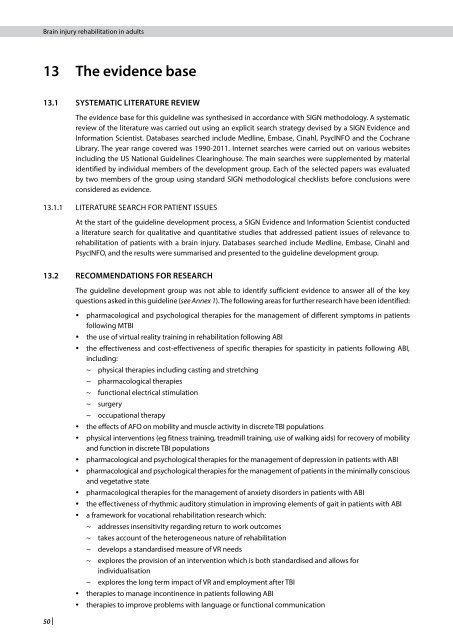sign130
sign130
sign130
You also want an ePaper? Increase the reach of your titles
YUMPU automatically turns print PDFs into web optimized ePapers that Google loves.
Brain injury rehabilitation in adults<br />
13 The evidence base<br />
13.1 SySTEMATIC lITERATuRE REVIEW<br />
50 |<br />
The evidence base for this guideline was synthesised in accordance with SIGN methodology. A systematic<br />
review of the literature was carried out using an explicit search strategy devised by a SIGN Evidence and<br />
Information Scientist. Databases searched include Medline, Embase, Cinahl, PsycINFO and the Cochrane<br />
Library. The year range covered was 1990-2011. Internet searches were carried out on various websites<br />
including the US National Guidelines Clearinghouse. The main searches were supplemented by material<br />
identified by individual members of the development group. Each of the selected papers was evaluated<br />
by two members of the group using standard SIGN methodological checklists before conclusions were<br />
considered as evidence.<br />
13.1.1 LITERATURE SEARCH FOR PATIENT ISSUES<br />
At the start of the guideline development process, a SIGN Evidence and Information Scientist conducted<br />
a literature search for qualitative and quantitative studies that addressed patient issues of relevance to<br />
rehabilitation of patients with a brain injury. Databases searched include Medline, Embase, Cinahl and<br />
PsycINFO, and the results were summarised and presented to the guideline development group.<br />
13.2 RECoMMENDATIoNS foR RESEARCH<br />
The guideline development group was not able to identify sufficient evidence to answer all of the key<br />
questions asked in this guideline (see Annex 1). The following areas for further research have been identified:<br />
y pharmacological and psychological therapies for the management of different symptoms in patients<br />
following MTBI<br />
y the use of virtual reality training in rehabilitation following ABI<br />
y the effectiveness and cost-effectiveness of specific therapies for spasticity in patients following ABI,<br />
including:<br />
~ physical therapies including casting and stretching<br />
~ pharmacological therapies<br />
~ functional electrical stimulation<br />
~ surgery<br />
~ occupational therapy<br />
y the effects of AFO on mobility and muscle activity in discrete TBI populations<br />
y physical interventions (eg fitness training, treadmill training, use of walking aids) for recovery of mobility<br />
and function in discrete TBI populations<br />
y pharmacological and psychological therapies for the management of depression in patients with ABI<br />
y pharmacological and psychological therapies for the management of patients in the minimally conscious<br />
and vegetative state<br />
y pharmacological therapies for the management of anxiety disorders in patients with ABI<br />
y the effectiveness of rhythmic auditory stimulation in improving elements of gait in patients with ABI<br />
y a framework for vocational rehabilitation research which:<br />
~ addresses insensitivity regarding return to work outcomes<br />
~ takes account of the heterogeneous nature of rehabilitation<br />
~ develops a standardised measure of VR needs<br />
~ explores the provision of an intervention which is both standardised and allows for<br />
individualisation<br />
~ explores the long term impact of VR and employment after TBI<br />
y therapies to manage incontinence in patients following ABI<br />
y therapies to improve problems with language or functional communication


